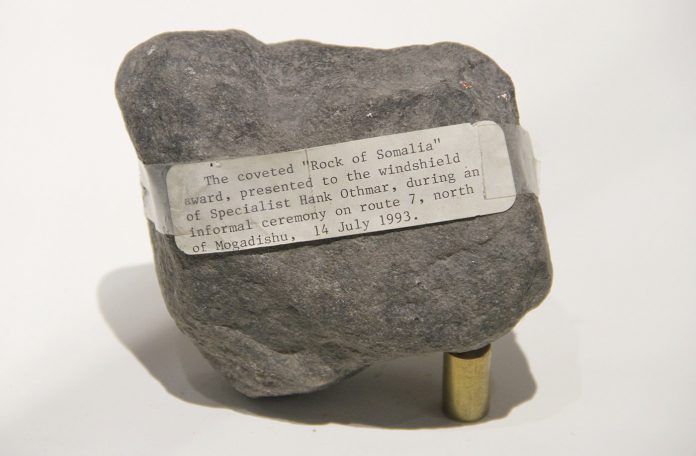When troops from the U.S. Army’s 10th Mountain Division entered Somalia in early December 1992 as a part of Operation Restore Hope, they were met with smiles. By the following summer, however, the Somalis stopped smiling and began throwing rocks at their Humvees.
The coveted “Rock of Somalia” Award
One rock that damaged a Humvee windshield was saved by an Army soldier and donated to the 10th Mountain Division and Fort Drum Museum. It’s called the “Rock of Somalia.”
“It is just a rock,” said museum Curator Kent Bolke. “A geologist could tell you more about it. There is truly nothing special about this rock — until you look at the file label that is taped to the rock.”
The description on the label, attached to the rock with Scotch tape, was typed by a soldier:
“The coveted ‘Rock of Somalia’ award, presented to the windshield of Specialist Hank Othmar, during an informal ceremony on route 7, north of Mogadishu, 14 July 1993.”
The aid mission turns violent Photo: Andy Flynn
Photo: Andy Flynn
Clashes between United Nations forces and Somali fighters loyal to warlord Mohamed Farrah Aidid had increased in June and July 1993. In August, a newly formed group called Task Force Ranger arrived in Somalia and was the lead contingent involved in the first Battle of Mogadishu on Oct. 3-4. That battle was chronicled in Mark Bowden’s 1999 book “Black Hawk Down” and the 2001 film adaptation of the book with the same name.
“Prior to the ‘Black Hawk Down’ incident, which was officially known as the Battle of Mogadishu, the 10th Mountain Division was in Somalia as the lead element for the United States Army, along with the United States Marines Corps, and our goal was to open up the supply lines from the port city of Mogadishu inland and help end the starvation that was happening in Somalia,” Bolke said. “And it was a really successful mission for quite a while. We came in, took away firearms from the local factions of the warlords and started to open up the supply lines and started to bring food to the starving masses.”
When Aidid’s soldiers ramped up attacks on U.S. and U.N. troops, Operation Restore Hope began turning more into a combat situation instead of a humanitarian aid effort. Kent Bolke, curator of the 10th Mountain Division and Fort Drum Museum. Photo: Andy Flynn
Kent Bolke, curator of the 10th Mountain Division and Fort Drum Museum. Photo: Andy Flynn
“The ‘Rock of Somalia’ is a bit of gallows humor, and soldiers who were there get a chuckle out of it because they remember being there and going through something similar to this,” Bolke said. “Somebody in a crowd threw the rock at a Humvee just because of the fact that there were soldiers inside and they were seen as being the bad guys.”
Operation Restore Hope began on Dec. 8, 1992 during the President George H.W. Bush administration. A day later, before dawn, U.S. Marines and U.S. Navy commandos arrived on the Somalia beaches at Mogadishu. The 10th Mountain Division was deployed on the same day the Marines arrived, sending thousands of troops from Fort Drum to join soldiers from countries such as France, Italy, Belgium, Morocco, Australia, Pakistan, Malaysia and Canada. The goal was to deliver food aid to people affected by the civil war in Somalia, and the 10th Mountain Division was the lead U.S. Army headquarters element.
Some visitors to the 10th Mountain Division may need some explanation about the “Rock of Somalia” to tell the whole story about Operation Restore Hope and the Battle of Mogadishu.
“If you’re a soldier,” Bolke said, “there’s really no explanation needed because it is a bit of that dark soldier humor.”
The Chocolate Chip uniform
Accompanying the rock in the glass exhibit case is a “chocolate chip” uniform similar to those worn by Army soldiers during the 1991 Gulf War and through the mission in Somalia.
“They call it the ‘chocolate chip’ because there are six primary colors,” Bolke said. “There’s a black and white to it that’s really meant for more of a rocky terrain, and it kind of gives the effect of looking like you are wearing a chocolate chip cookie.”
The name tag on the uniform reads “IRELAND.”
“Sgt. Ireland, who the uniform belonged to,” Bolke said, “came in not that long ago and asked me, ‘You know, you used to have a uniform on display. By any chance, do you still have it?’ I said, ‘By any chance is your last name Ireland?’ He said, ‘It is!’ And we came back and looked at his old uniform.”
The “Rock of Somalia” is one of Bolke’s favorite artifacts in the museum’s collection, mainly because of the dark humor it reveals about soldiers’ experiences in combat zones.
“It’s making the best of a worst situation,” Bolke said. “It’s kind of like complaining about the chow. It doesn’t matter how good it might be; you’re still going to complain about it.”
On Oct. 3, 1993, Task Force Ranger — 75th Regiment of the U.S. Army Rangers, Delta Force and the 160th Special Operations Aviation Regiment (Night Stalkers) — was sent into downtown Mogadishu to capture Aidid loyalists. During the operation, two UH-60 Black Hawk helicopters were shot down. The initial rescue convoy failed to reach the task force; however, the 10th Mountain Division’s Quick Reaction Force soon joined Malaysian armored cars, Pakistani tanks and the original convoy to rescue the embattled task force and reach the crash sites. Two 10th Mountain Division soldiers from a company of the 2d Battalion, 14th Infantry were killed in the rescue and 22 were wounded.

In all, about 38,000 soldiers from 23 nations and representatives from 49 humanitarian relief operations took part in Operation Restore Hope, putting food in the mouths of starving Somalis. The U.S. withdrew from Somalia on March 25, 1994, and the U.N. left on March 28, 1995.






























